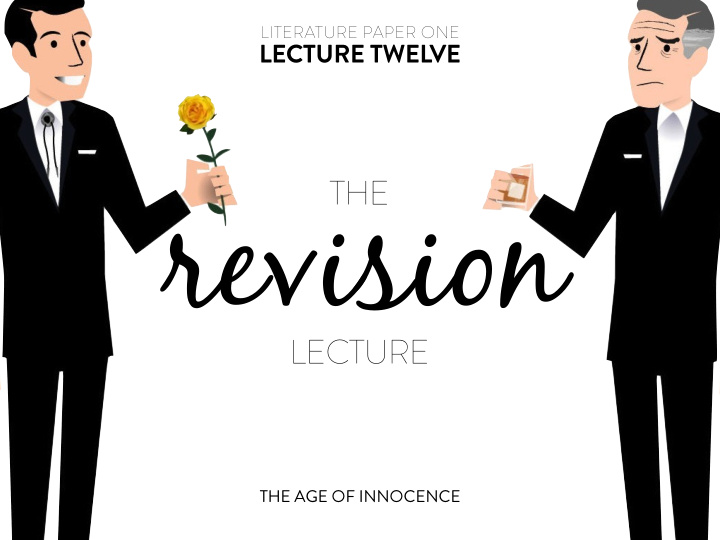



LITERATURE PAPER ONE LECTURE TWELVE revision THE LECTURE THE AGE OF INNOCENCE
INNOCENT NO MORE To read literarily is to appreciate and understand your text for its literary qualities - the METHODS - and how they contribute to the writer’s CONCERNS . To write literarily then is to ‘interface’ between the two: to show HOW STYLE CREATES MEANING .
THE RULES OF THE TRIBE SOCIAL FORM AND CUSTOMS INDIVIDUAL SACRIFICE ROMANTIC TRAGEDY HISTORICAL NOVEL THE NEW WOMAN AUTO-BIOGRAPHY BILDUNGSROMAN SOCIAL CRITIQUE SOCIAL SATIRE THEME Work VISIONS AND REALITIES FREEDOM AND ENTRAPMENT OTHERNESS / THE OUTSIDER PATRIARCHAL NORMS
“ ARCHER’S DILEMMA ” choice ROMANTIC ALSO A SYMBOLIC CHOICE OF TWO IRRECONCILABLE WORLDS
DOES HE HAVE A ? “ ARCHER’S DILEMMA ” choice Narrator’s Death & prison PERSPECTIVE MOTIFS “ Dilettante ” (4) “ Buried alive ” (114, 242) “ Young men ” (30, 78) “ Prisoner ” (267, 277) “ Ineffectual aim ” (184)
boy JUST A CITY BORN AND RAISED ON WEST 28TH ST visions AND LITERARY + ROMANTIC WHICH BECOME HIS ONLY reality of BOOKSHELVES of ELLEN of EUROPE of FRENCH of ART AUTHORS
CALL ME MAY ARCHER choice PERHAPS HE DOES MAKE A OF STATUS / MATERIAL WEALTH OVER being “dreadfully common” (165)
THE INTRICATE new york! CLOSED WORLD OF new york! ITS FORM ITS CUSTOMS ITS CONVENTIONS
new york! AS INEXORABLE POWERFUL ENGINE (35, 61, 277)
Avenue T Tribal Parochiality Hieroglyphic Dolls & Discipline & Fearful of WORLD PATTERNS HONOUR “DISINTEGRATION” (36) (68) (207, 212, 217, 222) (41, 69, 210)
“After all... we have lives of our own ” (257) sacrifice INDIVIDUAL (91, 138-9, 171, 258) ...as Mrs Archer put it, they “ owed it to society ” to show themselves at the opera (261)
METHODS Without madness
THE BIG PICTURE Remember that you have BOOK ONE (18 chapters) and BOOK TWO (16 chapters) How is the novel structured around the topic? If you find it difficult to construct an ‘argument’, just track the major plot points .
THE BIG PICTURE ‘Doomed to failure’ - presentation of relationships: The Archer-Olenska relationship develops through the course of Book One from Ch 8 until Ch 18 , where it appears ‘doomed to failure’ by May’s bringing forward of the marriage date. [Elaborate] Rekindled in Book Two , the affair meets its ultimate ‘doom’ only at the novel’s end , when May again extinguishes the flame. [Elaborate]
CROSS-REFERENCES Avoid merely pointing out similarity. Don’t bother stating that a similar method is used elsewhere. The ‘ PLACEMENT ’ of the passage matters. So does the LINK between the passage and other chapters.
CROSS-REFERENCES Write a critical commentary on this Ch 16 extract... The passage provides a summary of New York’s verdict on the Countess Olenska through Mrs. Welland’s perspective, confirming the reader’s impression of her exclusion from Chapters 1-2.
PERSPECTIVE It is important to point out WHO IS SPEAKING and in what tone. This ‘point of view’ used by the writer always serves a function.
PERSPECTIVE ‘Doomed to failure’ - presentation of relationships: Interestingly, Ellen provides an even more unsentimental account of relationships than Wharton’s ‘cold’, distant narrator. She dismisses, perhaps even derides, Newland’s wishful thinking that they could be ‘simply two human beings in love with each other’ without a care for the rest of the world.
PERSPECTIVE Write a critical commentary on this Ch 16 extract... The narrator presents to us to Archer’s sarcastic inner voice (‘he felt like answering’) which he chooses not to verbalise. While this illustrates his sympathy for Ellen and disdain for New York’s many hypocrisies, the writer in fact emphasises Newland’s cowardice.
DICTION + SYNTAX Write a critical commentary on this Ch 16 extract... Mrs. Welland’s use of absolute terms (‘completely’, ‘not at all’) portrays the extent of Ellen’s otherness and reinforces her air of superiority seen in the phrases, ‘No wonder’ and ‘I’m afraid’.
MOTIFS + SETTING ‘Doomed to failure’ - presentation of relationships: Early in the novel, the writer hints that a life with Ellen would be one of relative poverty via setting : Ellen’s ‘strange quarter’ is portrayed as ‘peeling’, ‘feeble’ and her neighbour Ned Winsett’s wooden house is ‘dilapidated’ and ‘dishevelled’.
OTHER METHODS CHARACTER ROLES Riviere and Winsett, Mrs. Archer / Welland / Mingott, Medora Manson CHARACTER NAMES Ellen Olenska , Poor Ellen, Mrs. Manson Mingott
BON VOYAGE bon chance! (GOOD LUCK) FIN.
Recommend
More recommend